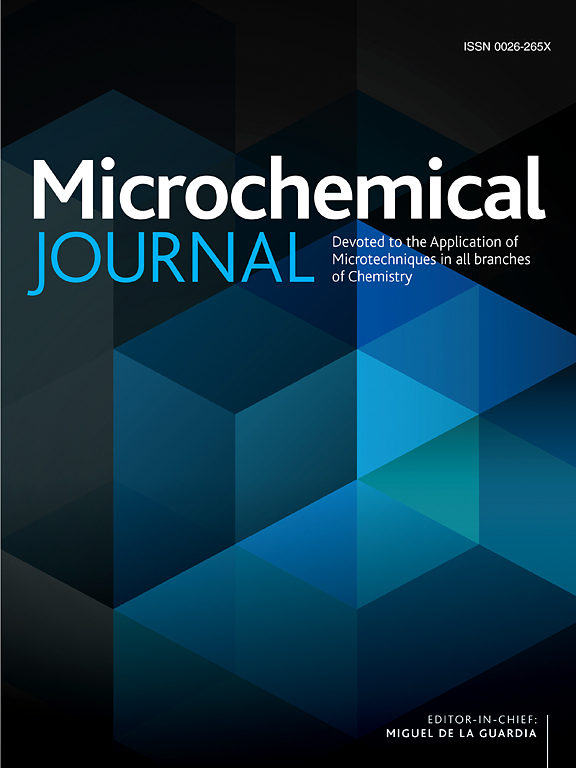Three-dimensional fluorescence spectral characteristic of flavonoids for citrus Huanglongbing disease early detection
IF 4.9
2区 化学
Q1 CHEMISTRY, ANALYTICAL
引用次数: 0
Abstract
To explore the potential of using flavonoid fluorescence characteristics in citrus leaves and peels for detecting citrus Huanglongbing (HLB), this study focused on Citrus reticulata ‘Shiyue Ju’ and utilized three-dimensional fluorescence spectroscopy for data collection. Excitation-Emission matrices (EEM) of flavonoid standards and citrus leaves and peels were acquired and comparatively analyzed. The concentration of HLB pathogens in citrus tissues was also assessed using qPCR. In order to identify the range of fluorescence bands that are sensitive to HLB, different machine-learning algorithms were used to construct classification models. Support Vector Machine (SVM) was proved most precise, with 93.1 % accuracy for leaves and 86.67 % for peels. The sensitive bands for leaves were EX (Excitation) = 375–455 nm, EM (Emission) = 490–570 nm and for peels were EX = 300–340 nm, EM = 430–470 nm and EX = 330–370 nm, EM = 425–465 nm. These bands correspond closely with the fluorescence signatures of nobiletin, hesperidin, and narirutin. It was further verified that HLB stress affected the changes in the content of flavonoids in the leaves and peels of ‘Shiyue Ju’. This study provides a reference for using flavonoid fluorescence in citrus HLB detection and presents a novel approach for applying spectral imaging techniques in citrus HLB detection.

黄酮类化合物三维荧光光谱特征对柑桔黄龙病早期检测的影响
为探索利用柑橘叶片和果皮类黄酮荧光特性检测黄龙病的潜力,本研究以柑橘网(citrus reticulata ' Shiyue Ju ')为研究对象,利用三维荧光光谱技术进行数据采集。获得了黄酮类化合物标准品和柑桔叶、果皮的激发-发射矩阵(EEM),并进行了对比分析。利用qPCR技术对柑橘组织中HLB病原菌浓度进行了测定。为了确定对HLB敏感的荧光带范围,使用不同的机器学习算法构建分类模型。结果表明,支持向量机(SVM)对叶片和果皮的识别准确率分别为93.1%和86.67%。对叶片的敏感波段为EX(激发)= 375 ~ 455nm, EM(发射)= 490 ~ 570 nm;对果皮的敏感波段为EX = 300 ~ 340 nm, EM = 430 ~ 470 nm和EX = 330 ~ 370 nm, EM = 425 ~ 465 nm。这些波段与皂素、橙皮苷和纳瑞芦素的荧光特征密切相关。进一步验证了HLB胁迫对‘世越菊’叶片和果皮中黄酮类化合物含量的影响。本研究为类黄酮荧光在柑橘HLB检测中的应用提供了参考,为光谱成像技术在柑橘HLB检测中的应用提供了新的途径。
本文章由计算机程序翻译,如有差异,请以英文原文为准。
求助全文
约1分钟内获得全文
求助全文
来源期刊

Microchemical Journal
化学-分析化学
CiteScore
8.70
自引率
8.30%
发文量
1131
审稿时长
1.9 months
期刊介绍:
The Microchemical Journal is a peer reviewed journal devoted to all aspects and phases of analytical chemistry and chemical analysis. The Microchemical Journal publishes articles which are at the forefront of modern analytical chemistry and cover innovations in the techniques to the finest possible limits. This includes fundamental aspects, instrumentation, new developments, innovative and novel methods and applications including environmental and clinical field.
Traditional classical analytical methods such as spectrophotometry and titrimetry as well as established instrumentation methods such as flame and graphite furnace atomic absorption spectrometry, gas chromatography, and modified glassy or carbon electrode electrochemical methods will be considered, provided they show significant improvements and novelty compared to the established methods.
 求助内容:
求助内容: 应助结果提醒方式:
应助结果提醒方式:


